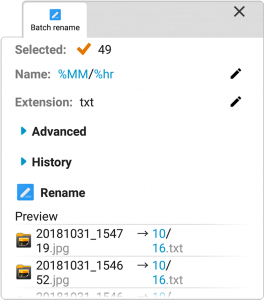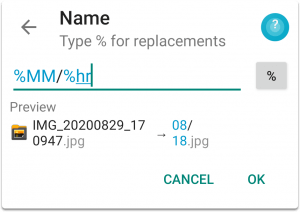Besides renaming single file, X-plore contains also tool for renaming multiple files.
This is a powerful tool that allows to:
- Change name
- Change extension
- Change case of file name
- Move files into sub-folders
- Use various templates to build new file name

- Name
- Extension
- Advanced options
Name template
In place of name you can type desired new name. Of course, giving same name to multiple files doesn’t make much sense. In case of name conflict, X-plore adds number (n) in brackets to avoid name duplication.
So in name field you can better type some template consisting of parts that will be replaced by various parameters. Each template starts with character % and some keyword after it, for example %hr is replaced by hour from file’s timestamp. You don’t need to remember the template keywords, just type % and you’ll get list of available keywords with their meaning.
You can mix the templates (starting with ‘%’) with normal text, for getting desired new name.

Types of replacement keywords
There are these types of keywords that are replaced by some text:
- original name: %name
- various formats of date and time (from file’s timestamp): %date, %time, %YYYY, etc
- audio tags from mp3 (artist/album/title): %artist, %album, %title
- range of characters from original name, format is: %[a-b], where a and b are indexes of characters in original name, starting from 0.
b is optional (if omitted, single character is taken), and each a/b can be negative which means that counter goes from the end of the filename (default is from start of the name) - counter (increasing for each selected file), format is: %012,2# important is # character, numbers before this are optional, 1st number represents starting value (default is 1), which you can prefix by spaces to reserve desired width for the counter, or by zero to prefix the counter by zeros, second number after comma is step by which counter increases (default is 1)
Examples of counters:
%# = simple counter from 1
% 5# = counter starting from 5, using 2 digits, filled by space for numbers <10
%0010,2# = counter starting by 10, using 4 digits, prefixing by 0, and increasing by 2
ⓘ Timestamp for JPG images is taken from Exif data stored in image, not from actual file’s timestamp, this way you get precise date when image was taken.
ⓘ For MP3 files, ID3 tags are read, so that you can rename music files by music artist/album/title.
Extension
Unless you set extension, it’s copied from original file name. If you set it, it is applied to all files. Note: if you rename folders, extension is not applied to them.
Advanced options
Here you can set case of characters (lower/upper/capital).
Renaming into sub-folders
You can use ‘/’ character in name template to move files into sub-folders (relative to folder where selected files are stored). For example, you can use name template %YYYY/%MM/%DD/%time to store photos into sub-folders by year, month and day, and files will be named by time of creation. The batch-rename tool will create needed sub-folders and move files there.
History
Batch rename tool remembers last entered parameters, so in next renaming you can choose from history to use same parameters as used previously.
Preview
While setting parameters for renaming, you can see Preview of how new names will look on your selected files (Note: only first few files are shown in preview, not all). This way you can be sure that you get desired result before doing actual renaming.
Proceed with rename
Once you select desired parameters for renaming, a Rename button will appear. After clicking it, actual renaming will be performed on selected files.